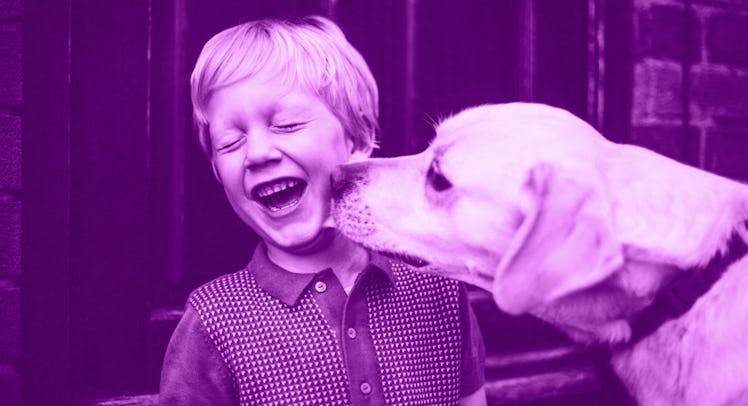5 Common Misconceptions About Dogs and Kids
Puppies aren’t perfect for babies, there’s no one dog for everyone, and dogs never go to farms upstate.

Dogs are good for kids, hands down. That is fact. However, the fandom that dogs have cultivated over several millennia of co-evolution sometimes blind parents to the potentially problematic relationships between kids and dogs — also, danger. Doglove is great and, again, having dogs around can be extraordinarily beneficial for children, but it’s important that parents see both their canines and their progeny clearly.
What follows are the widely accepted dog myths that parents need to shake. Shake! Good boy.
Puppies and Babies Go Together
Mixing puppies with babies is an explosion of adorableness that causes people to lose their damn minds. And with that kind of concentrated cuteness it would seem, then, completely natural for a baby and a puppy to occupy the same space. But sadly, that assumption is wrong. Puppies and babies can be a deadly combination.
Turns out that when children under 4-year-old fall prey to a dog attack, the family dog is responsible about half the time. When the rare fatality from a dog attack occurs the odds of the victim being a child are 7 in 10. Add to that that a huge majority of dog attack injuries to kids under 10 occur on the face and it’s clear some caution is in order.
Dogs are great for kids. But they are particularly great for older kids who have the impulse control to keep from inadvertently causing a dog to freak out and attack. Likewise, an older dog who has received training is much less of a risk than a puppy that just want to bite stuff.
One Dog Fits Most
Dogs rival humans in the diversity of their temperament. So it makes sense for parents in the market for a new canine to go beyond the intention of simply getting a dog writ large. It’s a much better idea to consider breed characteristics and try to get a dog that fits with the families specific style.
A lazy low-maintenance bulldog, for instance, is good for a busy family with a crazy schedule. They’ll be happy to bond with kids when kids settle. But a child who needs attention and has plenty to give in return might opt for a needy pug with lots of love to give. Active dogs like Labradors, on the other hand, will be great for outgoing and outdoorsy kids.
For those who don’t want to go to a breeder, rest assured that these breeds are pretty well represented in shelters too. It’s just a matter of spending time with the dog prior to adoption and paying heed to all of the information on the adoption sheet.
Good Dogs Don’t Need Training
Sometimes couples share a dog before they go fifty-fifty on a kid. In many cases, parents might feel their long-time furry companion has been exemplary enough that they will weather life with a kid just fine. But even good dogs will benefit from training before meeting a kid.
The fact is that adding a child to the pack can feel a bit threatening to the creature that was once the center of attention. That means, even for a pretty well-behaved dog, brushing up on obedience is key. The dog should be able to deal with distractions and follow commands because there will be instances where their behavior will be essential to keeping a kid from getting injured.
After some good command training, the dog should be introduced to children and babies so they know what to expect. Parents can even play baby sounds for the dog to help them get used to the inevitable wailing.
But even with training parents, need to make sure to keep on eye on the dog. A kid baby should never be left alone with a dog, even if they’ve been a trustworthy companion for years.
Dogs are Gross and Can Make Kids Sick
It would make sense that with all the poop, slobber and fur dogs would be considered a health risk for kids. However, it turns out that dogs can increase a child’s health outcomes in some pretty incredible ways. And much of the credit, ironically, is thanks to bacteria.
Research has shown that children who grow up with dogs have been colonized with two types of good bacteria: Ruminococcus and Oscillospira. These bacteria are linked to lower rates of obesity and allergies in children. And the dog benefits can even occur before the baby arrives. Another study found that women exposed to dogs during pregnancy had children with lower risk of eczema.
Parents who are still worried about the health risks of dogs, however, should encourage their kid to wash their hands after playing with their four-legged friend.
Kids Should be Shielded from a Dog’s Death
Shielding children from the reality of a pet’s death isn’t helpful. Telling a child that Rover went to live a happy life on a distant farm sounds like a sweet life, but it’s one that will ultimately be revealed as a lie, and doesn’t help the child who will probably mourn the absence of their pet regardless. Better to be truthful.
Children as young as three can begin to understand death as part of a cycle. And parents would do well to have open conversations about death when the opportunity presents itself. And it doesn’t have to be dog death. Parents can talk about dead plants or dead bugs. The important part is to answer questions truthfully.
Upon a dogs death, there’s no need to explain any grizzly details. But there’s no need to use euphemism either. Telling a child a dog has gone to sleep can wind up causing serious issues around bedtime.
Better to answer a child’s questions as honestly and age appropriately as possible and let them grieve their friend at their own pace.
This article was originally published on